Types of Springs: Failure Analysis and Prevention Techniques
 Dec 14,2022
Dec 14,2022

"Elastic" refers to the stretching force of objects, while "spring" refers to elastic parts. Objects made of metal or non-metal with jumping and elastic properties can use the rebound force generated by the stretching and twisting effect to drive other objects to move and produce automatic relaxation, recovery or other effects. Call it a "spring". English uses "Spring" as the name of spring, which means that it is an imagination of beating activity like a fountain of spring.
Most of the automatic, controllable, and slow-moving parts must use or install springs. In today's industrially developed world, springs have a wide range of uses, and they are also one of the mechanical elements. They are unique in the industry. Generally speaking, industrial supplies and daily necessities springs are widely used. Such as: spring beds/chairs, electrical switchgear, clocks, toys, TVs, refrigerators, washing machines, etc. in household products, the list goes on and on. The application of mechanical parts in industrial products, such as anti-vibration shock-absorbing, vibration insulation and other devices for vehicles, high-speed vibration buffer mechanism for internal combustion engines, balance and anti-vibration devices for compressors, instruments and meters, and automatic recovery devices for machinery and many more. It has a wide range of uses, and it can be detected as long as you pay attention to observation at any time.
Although the spring is a very small part in the entire manufacturing industry, its role cannot be underestimated.
Contents
Materials Used to Make Springs
5 Points: Analysis of Spring Failure and Technical Reference for Prevention
Tuofa Manufacturing Capabilities
4 Functions of Springs
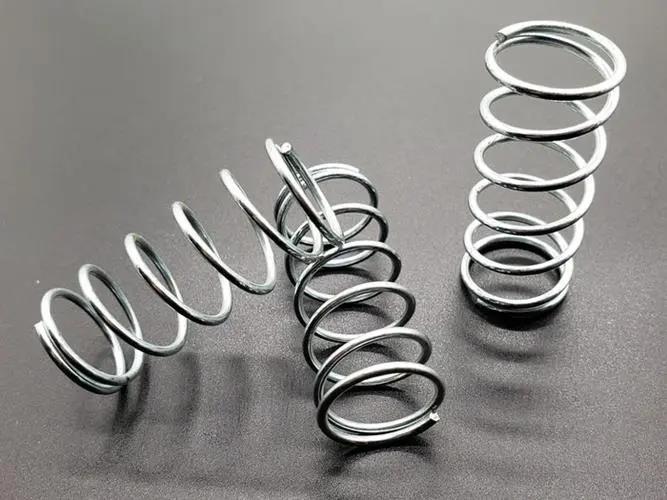
Spring is a widely used elastic part, which has the characteristics of easy deformation and high elasticity. The 4 main functions in real life are as follows, which will be introduced by China Shenzhen Tuofa CNC Machining.
1. Moderate shock and absorb vibration
Use spring deformation to absorb the energy of shock and vibration, such as buffer springs on vehicles and forging equipment, vibration-absorbing springs in couplings, etc.
2. Movement of the control mechanism
Use the elastic force of the spring to maintain the contact between the parts to control the movement of the mechanism, such as valve springs in internal combustion engines, brakes, clutches, cam mechanisms, control springs in governors, safety springs on safety valves, etc.
3. Storage and output of energy
Use the energy stored in the deformation of the spring to do work, such as clock springs, gun bolt springs, springs in the automatic return device of the tool holder in automatic machine tools, etc.
4. Measure the size of the force
Use the characteristic that the spring deformation and the load it bears are linearly related to measure the size of the load, such as the spring in the dynamometer, spring scale, and engine dynamometer.
Springs Features
(a); The relationship between load and deformation—the load P acting on the spring is proportional to the deformation S of the spring installed, and the constant of proportionality is K. That is, the load required to deform the spring unit is called the spring constant. P=KS Usually the spring constant is constant, but there are special occasions where the relationship between load and deformation is very complicated.
(b) ; Energy absorption—the spring has the property and function U of absorbing accumulated energy, which is usually expressed as U=1/2KS2, which is equivalent to the area of the triangle OMN. Those with greater energy absorption are more suitable for buffering impact and accumulation.
(c); Natural vibration——When external factors such as load and deformation are applied to the spring and these factors are eliminated, the spring performs natural vibration at a natural vibration frequency.
(d); Vibration insulation—in order to prevent the vibration of the machine from being transmitted to other buildings or machines through the foundation or to prevent the vibration of other machines from being transmitted from the foundation to the machine or instrument, the machine is supported by springs to attenuate the inherent vibration number transmitted by it. The coefficient ratio of the vibration number, etc.
(e); Alleviation of impact——When the spring is subjected to impact, in order to improve the buffering effect, all the kinetic energy of the object should be converted into the elastic energy of the spring.
Type of Springs
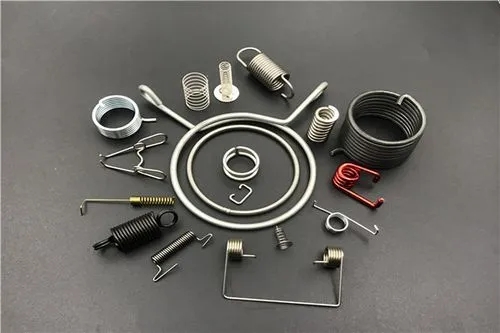
There are many types of springs, and there are various classification methods, none of which are conclusive, and can be roughly divided into the following five categories.
Classification by materials used
|
spring |
metal spring |
steel spring |
carbon steel spring alloy steel spring |
|
non-ferrous metal spring |
|
||
|
steel alloy spring nickel alloy spring other |
|||
|
non-metal spring |
rubber spring |
||
|
fluid spring |
air spring liquid spring |
||
|
Synthetic Resin Spring |
product spring |
||
| other |
The materials used cannot be clearly divided, that is, there are combinations of metal springs and rubber, air springs and metal springs, etc.
Classification by shape
|
spring |
Coil spring (cylindrical, round hammer, drum, barrel) |
|
Leaf spring |
|
|
Torsion spring |
|
|
Simplified spring |
|
|
Scroll spring |
|
|
Ring spring |
|
|
Coil springs |
|
|
Washers (spring washers, toothed washers, wave washers) |
|
|
Zigzag spring, buckle, etc. |
Classified by the pressure state of the plain pieces that make up the spring
|
spring |
withstand bending spring |
leaf spring, leaf spring twisted coil spring scroll spring coil spring toothed washer, wave washer |
|
withstand twisted spring |
tension coil spring compression coil spring torsion spring simple spring spring washer |
|
|
under tension compression spring |
ring spring |
|
|
spring with compound stress |
curved coil spring Coil spring for lateral load with coil spring |
Classification according to load-bearing time conditions
The classification is as follows according to the load-bearing time condition, but in the static condition, the static strength and stability must be considered, and in the dynamic condition, the fatigue strength and spring resonance must be fully considered.
Springs used in static conditions:
Load bearing provisions, adjustments - scales, safety valve springs, manometer springs, spring washers.
Storing energy—the spring of a clock, the record player, the watch spring of a machine.
Springs used in dynamic conditions:
Restorative use - valve spring, governor spring.
Vibration mitigation - frame springs for vehicles.
Absorption of impact energy - buffer springs for connectors and elevators.
In addition to being used in ordinary environments, it is also used in high or low temperature, and in corrosive atmospheres.
Other
When combined springs are used, they can be divided into series combined springs and parallel combined springs according to their combination methods. The series combined spring constant is the reciprocal of the sum of the reciprocals of the spring constants of each spring, and the parallel spring is the sum of the spring constants of each spring.
The characteristic of the spring is that it accumulates a lot of energy, but the energy absorption capacity varies from spring to spring, so when choosing a spring, it is advisable to choose the most attractive one, and find the maximum energy absorbed by the spring per unit volume.
|
Try Tuofa Now! Tuofa Engineer Support Team - Real human quotes are more accurate than software quotes |
Get a free quote |
Materials Used to Make Springs
The spring makes extreme use of the elasticity of the spring material. Of course, the higher the elasticity, the better the material. However, when designing the spring, the spring material requires physical, chemical, and mechanical properties. There are many things that should be paid attention to when selecting the material. depending on individual conditions.
The manufacturing process of the coil spring includes: rolling, hook making or finishing of the end ring, heat treatment and process performance test.
After the spring is formed, the surface quality inspection should be carried out. The surface should be smooth, free of scars, decarburization and other defects; springs subject to variable loads must also undergo surface treatment such as shot blasting to improve the fatigue life of the spring.
Elastic limit
The elastic limit is the stress relative to the maximum force that does not remain deformed when the force is removed after the material is deformed by a certain force. This is difficult to determine, but the elastic limit has a certain relationship with the tensile strength. Choosing a material with a high elastic limit is often equal to choosing a material with a high tensile strength. For this reason, it is appropriate to choose a chemical composition. Heat treatment or cold processing. The ratio of the elastic limit to the tensile strength—that is, the elastic ratio—varies with the processing method, but it is necessary to grasp the elastic domain of the state when used as a spring.
Spring coefficient
When force is applied to the spring material, the stress when generating unit strain is called the elastic coefficient value. The elastic coefficient of the basic spring material designed for the spring mainly depends on its chemical composition slightly changed due to heat treatment and cold processing , will be greatly reduced when the temperature is high.
Fatigue strength
The fatigue strength must be considered for springs bearing dynamic loads. The fatigue strength has a certain relationship with the tensile strength of the material, but it changes due to the decarburization of the surface state, cold working and heat treatment. These conditions are due to the manufacture of spring materials. The method, the manufacturing method of the spring changes and changes, so you must pay attention when choosing the material.
Hardenability
In order to improve the quenching effect, large springs need materials with good hardenability, and at least the center part must be quenched into a 50% Matian loose iron structure.
Shape and size
The mechanical properties of the spring material vary depending on the size, and the lack of special size and shape will be quite limited. The size tolerance of the spring material in manufacturing must vary from material to material, so it must be matched with the spring load characteristics. Choose materials based on precision, and conversely, materials must be very expensive when load characteristics are too demanding.
Heat resistance
|
Material |
Transverse modulus of elasticity Gx103(kg/mm2) |
Longitudinal modulus of elasticity E x103(kg/mm2)
|
temperature limit °c |
|
spring steel |
8 |
21 |
150 |
|
hard steel wire |
8 |
21 |
150 |
|
piano wire |
8 |
21 |
180 |
|
Stainless steel |
7 |
17.3 |
310 |
|
bronze |
4 |
10 |
400 |
|
Nickel |
4 |
11 |
|
|
phosphor bronze |
4.5 |
11 |
|
|
silver copper |
5 |
12 |
|
Some springs are used at a certain high temperature, usually the various mechanical properties of the spring material decrease as the temperature rises, and the spring characteristics decrease above a certain temperature. The commonly used temperature range table is as follows:
Corrosion resistance
Sometimes springs are used in corrosive environments. If the spring is uniformly corroded and reduced from the surface of the spring, the load will only be reduced corresponding to the size reduction. However, pitting corrosion is generally caused by corrosion fatigue imagination. When it is above, there will be deterioration above the estimated value. The corrosion resistance of the material mainly depends on its chemical composition, but there are many corrosion factors, so the material must be selected according to the environment. Even if the material is suitable, the corrosion resistance will also depend on heat treatment, cold room Processing varies.
Electrical conductivity
Electrical appliances, communication machines, etc. are often used for electrical conduction. At this time, copper alloy series such as brass, phosphor bronze, and beryllium copper can be used as spring materials.
Thermal expansion
Copper rust hair springs are very taboo to expand and contract due to temperature changes, and special materials should be used at this time.
Others
There are various problems such as the size of crystal grains, deflection of non-metallic inclusions, heat treatment deformation, processability, cold resistance, etc., and materials that are easy to handle must be selected.
5 Points: Analysis of Spring Failure and Technical Reference for Prevention
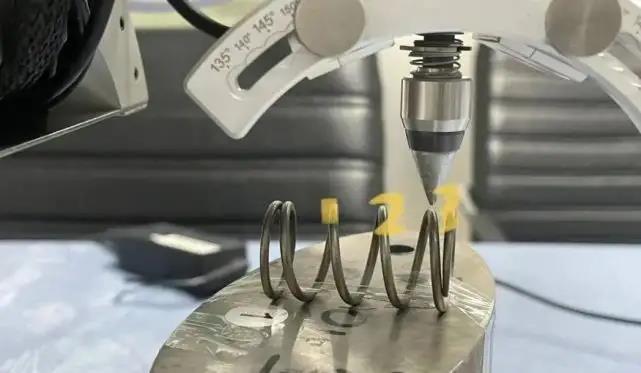
Springs are an essential part of general machinery. It plays the role of buffer balance, energy storage, automatic control, return, safety insurance and so on in the working process. During the use of springs, mechanical failures are often caused by various reasons. For this reason, it is necessary to discuss the causes of spring failure and preventive measures.
The main factors leading to spring failure are material defects, manufacturing defects, improper heat treatment, improper surface treatment and working environment factors. Spring surface defects, including collision scars, fretting wear, pits, etc., are the main causes of spring failure, accounting for 50%; cracks account for 20%; loose 13%; decarburization, heat treatment, and surface strengthening account for about 3% . Spring failure can be caused by one cause or a combination of several factors. Therefore, the failure analysis of the spring must first conduct various investigations and analyzes on the failure phenomenon of the example, find out the failure mode, find out the reasons and factors of the failure, and then propose improvement measures.
The spring material causes the spring to fail
1. Due to the different smelting methods of steel, there will be inclusions in the steel, resulting in different degrees of early fatigue failure of the spring. Too many inclusions or too large size, poor uniformity will affect the mechanical properties of the material, prone to early fatigue failure.
For example: for the car torsion bar spring suspension model SY6480 (Ф22mm) from a company broke the warehouse of a new car at that time. According to the analysis, the fracture is caused by coarse and brittle inclusions on the subsurface of the spring.
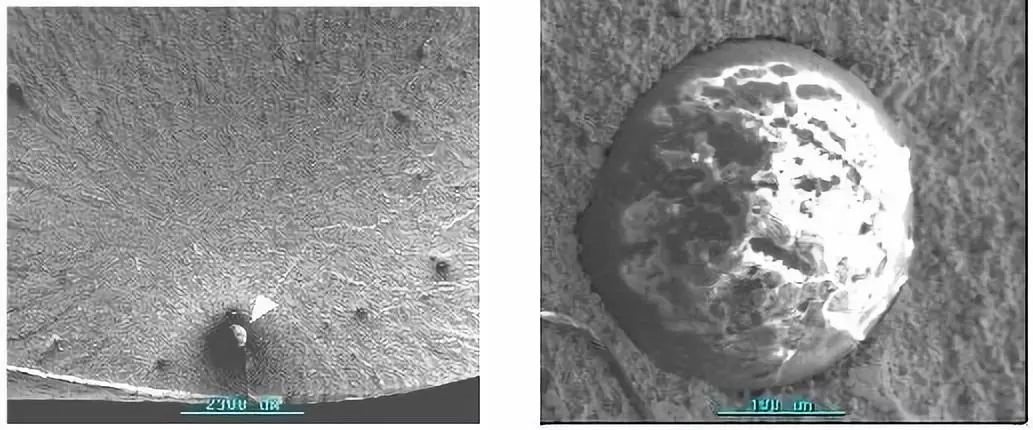
Precautions: Spring materials must have good metallurgical quality, such as strict control of chemical composition, high purity, and low inclusion content. At the same time, uniformity and stability of material composition and structure are also required. In order to reduce harmful gases and impurity elements in steel and improve the purity of steel, smelting technologies such as vacuum smelting and electroslag remelting should be used.
2. Defects that may occur during the rolling process: residual shrinkage tubes and center cracks; folding defects; linear defects, scratches; surface pits; overheating, orange peel-like surfaces, pits; these may cause spring failure. Therefore, steel mills should try their best to avoid and eliminate the defects produced in the rolling process. The spring factory should strengthen the quality inspection of spring raw materials, and try to use materials with good surface quality.
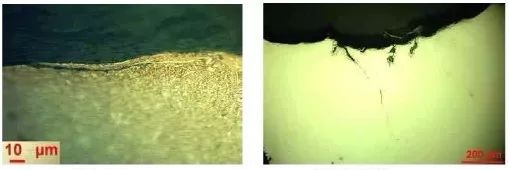
When cold-formed springs are formed, the surface defects of the springs may be caused by poor process equipment or improper adjustment operations during spring processing. For example, when a spring is cut on an automatic spring coiler, the cutter can insert the inner surface of the wire near the spring. Due to the high heating temperature of the thermoformed spring, orange peel defects appear on the surface of the spring, which greatly reduces the fatigue life of the spring. Or, in the hot forming process, due to the low heating temperature, the plasticity of the steel is not enough. During the hot forming process, the surface stress of the spring exceeds the strength limit of the material, resulting in cracks. Therefore, the quality inspection of the spring surface must be strengthened in the manufacturing process to avoid surface defects.
The spring failure during the manufacturing process
When cold-formed springs are formed, the surface defects of the springs may be caused by poor process equipment or improper adjustment operations during spring processing. For example, when a spring is cut on an automatic spring coiler, the cutter can insert the inner surface of the wire near the spring. Due to the high heating temperature of the thermoformed spring, orange peel defects appear on the surface of the spring, which greatly reduces the fatigue life of the spring. Or, in the hot forming process, due to the low heating temperature, the plasticity of the steel is not enough. During the hot forming process, the surface stress of the spring exceeds the material strength limit, and cracks are prone to occur. Therefore, the quality inspection of the spring surface must be strengthened in the manufacturing process to avoid surface defects.
Defects in the heat treatment process lead to spring failure
When heating or cooling, the temperature distribution on the surface and center of the spring is uneven, which will generate thermal stress, and the phase transition process will generate tissue stress. When the total amount exceeds the strength limit of the material, it will cause cracking. This kind of defect is more common in large springs quenched in water, and the cracks cannot be repaired and can only be scrapped. In addition, defects in raw materials, such as residual shrinkage of steel, white spots, cold working tool marks, scratches and wrinkles during cold drawing and hot rolling, etc., will also cause stress concentration and cracking during quenching. During the quenching heat treatment, due to the short and shallow folded cracks on the original surface, the cracks expanded radially to 3.9 mm. In a fatigue test, it expands first until it reaches a critical size and causes the spring to break instantaneously. Improper heat treatment will produce abnormal structures such as coarse quenched martensite; first eutectoid ferrite or free ferrite; carbide segregation; spring heat treatment deformation; surface oxidation and decarburization will cause spring failure.
For example: 60Si2MnA hot-formed spring in a factory, d = 25, d = 120, n = 5, rolled at 900-950°C, quenched once after rolling, tempered at 470-490°C, after loading, the spring continues for several early failure. Inspection of the failed springs revealed quench cracks in individual springs. Through the analysis of the gas composition in the furnace, it was found that the gas composition was not suitable for about one month, and the calorific value was too high, resulting in excessive furnace temperature, overheating of individual springs, coarse austenite grains, and quenching cracks after quenching in water. Due to the strong cooling ability of water, the temperature difference between the spring surface and the core increases in the temperature range of austenite to martensite transformation. Due to the different order of martensite transformation, it causes many cracks due to the large structural stress.
Preventive measures: In addition to strictly controlling the heating temperature and holding time, it is also important to control the atmosphere in the furnace. Regularly analyze the heating gas composition to ensure normal heating. In order to reduce deformation and prevent quenching cracking, except for super large hot-formed springs, generally hot-formed springs are cooled in oil.
Unreasonable surface treatment process
1. The surface shot peening process, shot peening equipment, process method and operation level have a great influence on shot peening. If the manufacturer does not regard the shot peening process as an important strengthening process, it must pay full attention to the shot peening process. If it is necessary to control or detect the effect of the shot peening process, the shot peening may not get the desired strengthening effect, and may even become the cause of early failure of the spring.
The surface of spring raw materials imported from the factory has been nitrided and has high surface hardness. After shot peening, the surface cracks and eventually breaks. Therefore, for different materials and different processes, it is necessary to choose a suitable shot peening process.
2. During the electroplating process, the surface of the spring and the plating layer contain a large amount of hydrogen. If it is not removed in time and fully, it will cause hysteresis and failure of hydrogen during the working process. Sometimes before oxidation treatment or phosphating treatment, in order to remove scale and rust on the surface of the spring, pickling is required. When excessive pickling causes a large amount of hydrogen to penetrate into the parts, but fails to remove the hydrogen in time and fully, it will cause hydrogen embrittlement failure of the spring.
For example: a 70" cold-drawn carbon spring steel wire with a diameter of 0.6mm is plated with cadmium to make a torsion spring with a diameter of 4.0mm, which breaks during assembly. Energy spectrum analysis (EDS), metallographic analysis and scanning electron microscopy (SEM ) macroscopic and microscopic inspection and analysis of the fracture. The results show that the residual tensile stress generated by the spring during the winding process and the contact with the hydrogen-containing medium before plating make a large amount of hydrogen distributed in a dispersed form and form cracks along the crystal. In the external force Under the action, the spring brittle fracture occurs along the crystal.
Effect of working conditions on spring failure
Effect of loading conditions on spring failure
There are many springs in general machinery that are affected by shock, such as the plunger spring of a syringe pump. This type of spring often breaks on the second and third coils, because the shock load is first applied to the second and third coils and cannot be transferred to the other coils quickly enough. The first few rounds were hit the hardest and deformed more than their respective rounds. More.
The dynamic effect should be considered in the design, and the resonance between one end of the spring and the natural frequency of the spring should be avoided as much as possible. However, sometimes resonance phenomena are unavoidable and the stress amplitude increases by more than 5%. Therefore, corresponding measures must be taken, such as using a higher natural frequency to prevent it from resonating with lower harmonics. Reasonable design of the cam profile to reduce the pitch of the working stage. Reduce the pitch at the end of the spring to change the natural frequency of the shock; add frictional forced damping in the middle of the spring.
Strictly speaking, when the spring works, it is impossible to act on the geometric centerline of the load, and will form an eccentric load, which is always offset by the distance e. This eccentric load will create additional stress, which will significantly reduce the safety pressure of the spring, leading to premature failure. In addition, it is dangerous to overload the spring when it first starts working. The accumulation of initial overload damage reduces the fatigue limit of the spring, leading to early fatigue fracture.
Effect of environmental factors on spring failure
In corrosive environments, alternating loads can cause corrosion fatigue. Because the corrosive environment will accelerate the initiation and expansion of fatigue, it will significantly reduce the fatigue life of the spring. For example, under fresh water corrosion, the endurance limit of spring steel samples in the atmosphere is only 10% to 25%.

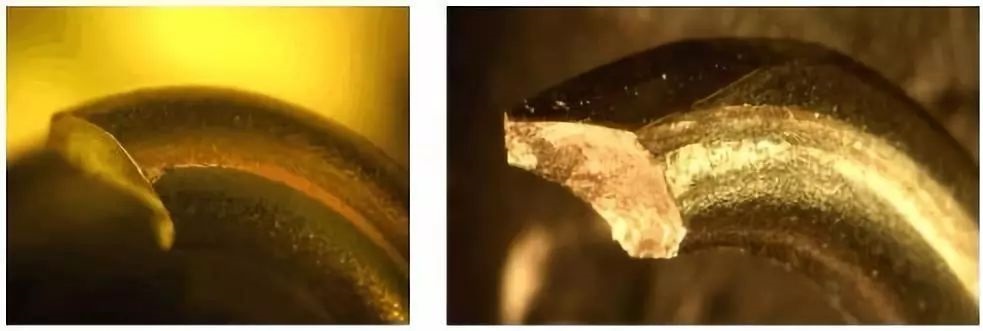
Example: The fracture failure of the main valve control seat spring of a steam turbine in a power plant was analyzed. The results show that the chemical composition and structure of the spring material meet the national standard. The main cause of its early fatigue fracture is the corrosion pit on the surface of the spring; corrosion pits will be formed during the placement of the spring before use, which improves the environment and shortens the placement time of the spring. Time can avoid corrosion pits.
In spring parts, such as the rings at both ends of the helical compression spring, the hook of the tension spring, the fixed end of the torsion bar, and the fretting wear between the blades. The clutch damping spring of a certain company broke during the fatigue test. After analysis, the spring is impacted and rubbed by external force, which makes the position of the contact area of the spring transition ring shift, which not only produces micro-vibration wear on one plane, but also produces different micro-vibrations. The overlap of the wear surfaces leads to stress concentration at the intersection of the wear surfaces, resulting in fracture.
Preventive measures: It can be solved by using corrosion-resistant materials or surface treatment methods that form a protective layer on the surface of the spring.
Fretting wear and collision marks and pits
Preventive measures: In addition to eliminating vibration and improving structural design, various surface treatments such as ion implantation, chemical heat treatment, shot peening, rolling and other surface hardening processes are used to improve the wear resistance and fatigue properties of the surface, which can improve its resistance Abrasion ability. The process of fretting damage can also be slowed down by reducing the coefficient of friction of surfaces (including solids, semi-solids, and liquids) through lubrication.

There are many cases of spring failure due to scratches and pits on the surface of the spring, which account for a large proportion of component failures. For example, a company's clutch plate springs prematurely fatigued and fractured due to severe scratches on the spring surface. This kind of surface defect may occur in the spring manufacturing process, or it may collide during use. The manufacturing process has been described above. During use, users should check the use environment to avoid the spring being affected.
Effect of working temperature
Because different materials have different heat resistance properties, when the temperature rises, the metal will expand with the increase of heat, and the corresponding dimensional changes will change the various properties of the spring. Not only that, the elastic modulus E and shear modulus G of the spring will also decrease, so even under the condition of constant load, the deformation of the spring will increase. In addition, under the joint action of stress, temperature and time, deformation and relaxation will be important forms of spring failure.
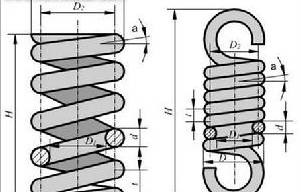
For example: the compressor valve spring is made of piano wire, if it is operated at a temperature above 160°C for a long time, almost all of the valve springs will be compressed in the valve seat hole due to stress relaxation and height reduction, and the working performance of the valve spring will be lost. and fail.
Low temperature is the opposite of high temperature condition. Low temperature will increase the elastic modulus, hardness and strength of the material, but will reduce the plasticity and toughness of the material. Especially when the temperature is lower than the cold-brittle transition temperature of the material, the brittleness of the material will be very serious. For example, at -40°C, the spring will often break into several sections under the impact load.
| Let's Start A New Project Today |
| Get a Free Quote |
Conclusion
With the development of spring application technology, spring is an elastic component widely used in mechanical and electronic industries. Spring can produce large elastic deformation when loaded, and convert mechanical work or kinetic energy into deformation energy, while unloading The deformation of the rear spring disappears and returns to its original shape, while transforming the deformation energy into mechanical work or kinetic energy.
Nowadays, in the society with continuous improvement of technology, spring products are favored by people in the process of use. A spring is a mechanical part that uses elasticity to work. Generally made of spring steel. Although the spring is small, as a general basic part, it has a large quantity and a wide variety of varieties. It is used to control the movement of the parts, alleviate the impact or vibration, store energy, measure the size of the force, etc., and is widely used in machines and instruments. Almost all areas of the global economy are involved. At present, there are five major markets that have a large demand for spring products: transportation, daily hardware, instrumentation and electronic appliances, industrial and mining accessories, and overseas export markets.
Tuofa Manufacturing Capabilities
Founded in 2006, Tuofa is a full-service contract manufacturer specializing in complete assembly, custom CNC machining, sheet metal fabrication, and 3D printing services for multiple markets. We are a flexible, adaptable, rapidly scalable, integrated Chinese manufacturer of close tolerance components and assemblies of virtually any size and made of virtually any material including Aluminum, Stainless Steel, High Strength Steel, Titanium, Copper, polymer.
Want to make your product a better experience for users? Why not contact Tuofa immediately, Tuofa's pursuit of excellence in design will always gradually bring more excellent products and valuable feedback to customers. We are always pursuing a better user experience and creating better designs.
 Tel/WeChat:
Tel/WeChat:  Email:
Email: 
 Home
Home
 The Definitive Guide to Rivets: Types of Rivets and Riveting Processes
The Definitive Guide to Rivets: Types of Rivets and Riveting Processes 







